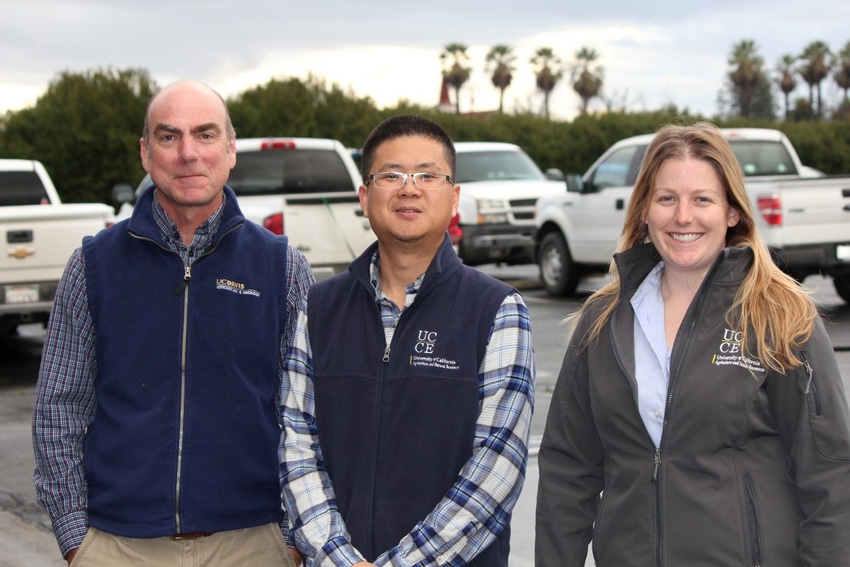January 18, 2017

During this year’s San Joaquin Valley Grape Symposium held Jan. 11 in Easton, Calif.
Allied Grape Growers President Nat DiBuduo praised current research underway by the University of California and others.
DiBuduo said, “We have a good future here.” But he also lamented the decline in the number of grape growers in the San Joaquin Valley.
“I want to congratulate you who are here and to support you and the university and to make sure you are more sustainable,” he said, as more than 100 people gathered as a rare weeklong storm pelted the area.
“Ten years ago on a rainy day, there would have been twice or three times as many here today,” DiBuduo said. “That’s the sad part of it. Back then, if you looked to your left or right, you might have asked, “Who is going to be growing almonds or pistachios?”
He asked wine grape researchers to conduct a production cost study so growers can get a better handle on what they need to do to stay in business. For some varieties, DiBuduo said it could be necessary to get 17 tons per acre to remain sustainable.
The grape leader said UC researchers are looking at how to make that happen, noting that research could answer these questions that could help revitalize the industry.
Larry Williams, with UC Davis’ Department of Viticulture and Enology, discussed deficit irrigation, saying this process during a drought could make it a tall order to achieve 17.5 tons in production. But he also said deficit irrigation can result in strong yields, particularly if the period of reduced irrigation is properly timed.
Sustained deficit irrigation, he said, had only minimal effects on berry weight. But early season stress significantly reduced berry size and yield across cultivars, compared to late-season stress treatments. Early-season stress also delayed the accumulation of sugar. Clusters per vine were also reduced with early-season stress.
Symposium speakers also discussed salt and drought tolerant rootstocks, an update on laws and regulations on use of pesticides and herbicides, and vertebrate management – particularly coping with gophers and ground squirrels whose tunnels can divert water and whose actions can kill vines.
Andy Walker, a UC Davis grape breeder, is heading a team looking into varieties of grapes that could provide resistance to drought and salt, along with resistance to phylloxora and nematodes. The team is also looking at root fibrosity as a predictor of drought tolerance.
Plant material from the southwestern U.S. has been a source of resistance to drought and salt.
Bill Griffin of the Fresno County Agricultural Commissioner’s office discussed common violations on pesticide use and worker safety inspections. He said the most common non-compliance is based on emergency medical care posting, personal protective equipment, and providing handler decontamination facilities.
For example, it is not enough to just post that an emergency is to be met by calling 911. Instead, it is required to post the name of the nearest medical facility, its address, and its phone number.
Another act of non-compliance is not complying with labels on the pesticide used.
“The label is the law,” said Griffin, stating what crops the material can be used on and the protective gear to be worn during use.
New for 2017, he said, is a requirement that there must be a system for providing at least six gallons of water for a gentle eye-flush for about 15 minutes in the event of an emergency at the mixing and loading site for pesticides if the product labeling requires protective eyewear or closed mixture system use.
Mike Konda, wildlife damage and pest management supervisor with the Fresno County Agricultural Commissioner’s Office, discussed vertebrate pest management in vineyards.
In 2009, he said rodent and bird damage in 10 California counties ranged from $168 to $504 million. In Fresno County, the revenue losses ranged from $18.1 million to $54.1 million.
Pocket gophers and squirrels damage vines and divert irrigation water through their burrows. Trapping for either rodent can be time consuming.
Baits, including strychnine on milo, can be used on gophers, along with flooding, explosive devices, and bio-controls. A machine called a gopher burrow builder can also be used to put bait in place.
Pre-baiting trips is recommended for trapping ground squirrels. Supply the squirrel population with bait for several days without setting trapes. This allows the squirrels to get comfortable foraging for food at the traps.
But don’t put out too much material, Konda said. Otherwise the critters will simply enjoy their feast and stay clear of the traps.
You May Also Like




